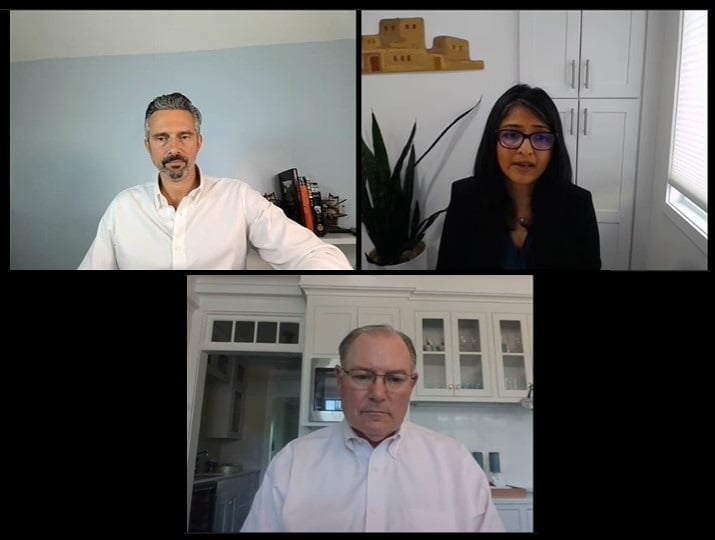Striving for Risk Mitigation Without the ‘Headaches’

The subject was reshoring, but Bindiya Vakil’s assessment could have applied to a number of manufacturing and sourcing dynamics discussed during last week’s “Uncovering Supply Chain Risk Concentrations in 2024” webinar.
“A lot of times, companies think they have de-risked,” said the CEO of Resilinc, a Milpitas, California-based provider of supply chain risk management research and analytics, “when they’ve just exchanged one set of headaches for another set of headaches.”
The webinar was hosted by RapidRatings, a New York-based software-as-a-service (SaaS) technology firm, and featured Vakil and Thomas W. Derry, CEO of Institute for Supply Management® (ISM®). They and RapidRatings executive chair James Gellert discussed such risk issues related to the economy, sustainability, geopolitics and more.
The China Conundrum Continues
Vakil identified five supply chain risk trends: (1) climate events, (2) labor shortages, (3) cybersecurity, (4) geopolitical turmoil and (5) environmental, social and governance (ESG) regulations compliance. Mitigate such risks by moving operations from China? That sentiment continues, she said, but it’s critical to note that while many companies have reduced their reliance on China, they might never eliminate it.
“If you think you have decoupled when you haven’t, that’s a serious situation,” Vakil said. “The companies that have not left China are, in many cases, suppliers to the companies that have. When you look two or three tiers deep, there’s China in you supply chain. Another factor is that we are seeing government we see government enacting a lot of policy that (that limits products or components made in China) without really understanding the impact on business as a result of having to comply with these policies.”

Clockwise, from top left: RapidRatings executive chair James Gellert, Resilinc CEO Bindiya Vakil and Institute for Supply Management® (ISM®) CEO Thomas W. Derry discuss risk issues during a recent webinar.
One of the specific topics raised was semiconductors, particularly in the wake of rising tensions between Beijing and Taiwan, which has dominated global chip production. The CHIPS and Science Act, signed by President Joe Biden in 2022, will boost domestic production in the long run, Derry says, but in the short term, companies can explore updating technologies to accommodate higher-performing chips.
“A lot of our products are still built on those older technology nodes,” he said. “If you’re getting it from TSMC (Taiwan Semiconductor Manufacturing Company), they’re doing some (smaller-nanometer) technology. A prudent risk management strategy is to talk to your suppliers about how do I leapfrog technology? How do I move faster into more current technologies so I’ll be able to access the new semiconductor supply that’s coming online?”
A Business Bankruptcy Boom
A trend that emerged in 2023 — corporate bankruptcies — could be intensifying this year, Gellert said. According to RapidRatings research, Chapter 11 filings increased 43 percent year over year during the first quarter. The ratio of private firms filing for bankruptcy over public companies was 9-to-1, he added. And many of their impacted companies are suppliers.
“We’re clearly facing a period where higher interest rates and persistent inflation is affecting suppliers of all types as well as their customers downstream,” Gellert said. He added, “And that squeeze is causing many of them to change the way they are operating even prior to an instance of bankruptcy. But we are seeing the ultimate result of bankruptcy happening more frequently, and I believe that will continue during the next couple of years.”
Gellert cited an average cash conversion cycle increase for surveyed private companies, from 54 days in 2019 to 84 days at the end of last year. Those payment delays put a squeeze on working capital, which can threaten investment in operations efficiency, cybersecurity, R&D or ESG compliance.
“They have to cut corners somewhere,” he said. The risk is exacerbated at middle-market companies, which typically have fewer options to financial stress.
ESG Becomes a ‘Compliance Issue’
While ESG investing has taken darts from politicians and commentators in the U.S, standards enforcement continues globally. “ESG no longer just means to do it for the good of the planet or for brand protection, it is now a compliance issue.” Vakil said. “We don’t see these laws stopping, and companies will need to adhere to them.”
The European Union’s Corporate Sustainability Reporting Directive, for example, mandates ESG performance be included on a company’s annual financial report.
“To the extent firms may have engaged in greenwashing or set goals that were maybe more public relations than anything else, they won’t get away with that going forward,” said Derry, who said sustainability practices and personnel must be integrated into procurement operations, not siloed.


